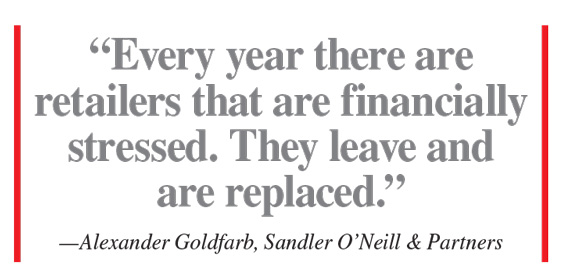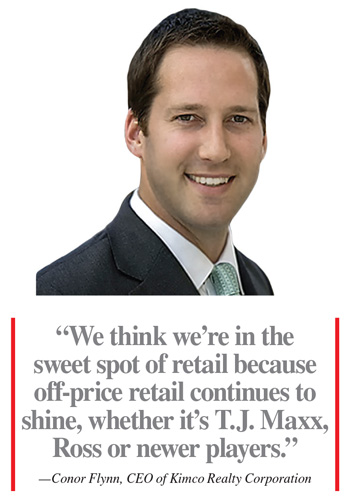Despite the country’s mall woes, retail real estate investment trusts have had a nice run over the past five years, and analysts say they still have plenty of juice.
The FTSE NAREIT Retail REIT index, which measures retail REITs’ performance, returned on average 14.9 percent annually in the five-year stretch that ended March 31. It beat eight of the nine other REIT types, including industrial, office, residential and mortgage REITs; self-storage REITs were the exception.
And while gains are unlikely to continue at such lofty levels, the future looks bright for the top performers, even as online retail sales take a bite out of brick-and-mortar retail, according to industry sources.
“Retail REITs in general are a good place to be as a sector,” James Sullivan, senior REIT analyst at the investment research firm Cowen and Company, told The Real Deal. “Fundamentals remain positive for the retail business. There’s a very favorable supply–demand balance” for retail real estate. “Supply growth is low compared to past cycles.”
Retail REITs fall into two major categories: those involved with malls and the ones in the business of open-air shopping centers.

Simon’s King of Prussia delivers on foot traffic.
Mall REITs today are benefiting from the fact that mall companies in general are finding it difficult to find available sites for Class A malls (enclosed shopping centers that house high-end department stores and other luxury retailers) since land is scarce in desirable areas. Such malls have occupancy rates in the mid 90-percent range, and rents on new and renewal leases are jumping 15 percent to 20 percent from those in expiring leases, Sullivan said.
Meanwhile, the outdoor shopping center REITs are reaping advantages from the fact that new space at outdoor shopping centers has been growing at less than 1 percent annually for the last seven years, according to the International Council of Shopping Centers. Demand for space is rising about 2 percent annually, said Steven Brown, manager of two real estate funds for American Century Investments.
At top-performing shopping centers, such as Kimco’s Lincoln Hills Town Center in Lincoln, California; Federal Realty’s Assembly Row in Somerville, Massachusetts; and Equity One’s Piedmont Peachtree Crossing in Atlanta, anchor boxes have an occupancy rate of 98 percent and interior stores of 89 percent to 90 percent, said Jay Carlington, an analyst for Green Street Advisors.
The macroeconomic environment is positive for retail REITs, analysts said. “Consumer spending has risen modestly over the last 12 months, but declining gas prices are having a positive impact,” Brown said. “If we continue to see job gains of 200,000 a month, that’s a favorable backdrop for improvement in retail spending.” Personal spending rose 3.4 percent last year, and the economy added 215,000 jobs in March, according to the U.S. Department of Commerce and the Bureau of Labor Statistics.
For investors gravitating toward retail REITs, “it’s important to pick your spots,” said Alexander Goldfarb, senior REIT analyst at Sandler O’Neill & Partners. “Collectively you want [companies with Class] A malls or quality shopping centers. That’s where retailers gravitate because that’s where consumers gravitate.”
Though online sales have surged to account for about 10 percent of retail sales overall as of last year, according to Forrester Research, analysts and REIT executives say the Internet is not a mortal threat to bricks-and-mortar retailers or REITs. Instead, those retailers are upgrading their Web presence, while Internet retailers are expanding their physical presence.
“People thought e-commerce would be the death of retail, and now there is talk of Amazon opening stores,” Conor Flynn, CEO of Kimco Realty Corporation, told The Real Deal. “It’s all about omnichannel; retailers must be good at both, ” he said, using the industry term for the merging of operations so customers can order products online then pick them up at a store or examine them in a shop and order them via its website.
Retailers have found that online sales rise 50 percent in areas where they open stores, said Flynn, whose REIT is the country’s largest owner and operator of open-air shopping centers. “Data show that physical stores remain important for brand and sales growth,” he said.
To Goldfarb, online sales are merely replacing the 10 percent of retail sales that used to go to catalogs. “There have been … store closings since Adam and Eve left the garden, but consumers gravitate to busy centers,” he said. “Every year there are retailers that are financially stressed. They leave and are replaced. Consumers have a need for a physical, tactile experience.”
While “it’s foolish to think that malls will go away, the issue of the Internet looms over everyone and will continue to evolve,” said Barry Vinocur, publisher of REIT Zone Publications. Lately malls and shopping centers have moved to ratchet up the experience component of their facilities, bringing in restaurants, movie theaters and other entertainment.
Not all retail REITs are doing well, though. Pennsylvania Real Estate Investment Trust sold 13 of its worst-performing malls, which helped lift its stock price by 32 percent since Feb. 11. Real estate research firm Green Street Advisors predicts that about 15 percent of the country’s 1,000 malls will close or be shifted away from retail use over the next 10 years.

So what are analysts’ favorite retail REITs in 2016? On the mall side, they cited Simon Property Group, General Growth Properties, Macerich and Taubman Centers. On the outdoor shopping center side, they preferred Kimco, Federal Realty Investment Trust, Brixmor Property Group and DDR Corp. Here’s a closer look at these eight REITs:
Simon Property Group is often viewed as the top dog among U.S. mall operators, due to its ability to adapt to changes in the retail landscape. The REIT is the biggest mall owner in the country and owns some of the top performers, including Copley Place in Boston; King of Prussia mall in King of Prussia, Pennsylvania; and Houston Galleria in Houston. Simon continues to strengthen its balance sheet by replacing old debt that’s carrying a high interest rate with new debt bearing a lower rate, according to industry sources. Vinocur said the REIT has “continuously delivered superior financial returns” and cited the company’s addition of an outlet division that’s performed well and its creation of an incubator for venture capital investments (see related story on page 38).
Simon Property Group posted net operating income growth of 3.7 percent in 2015 with revenue of $5.27 billion, representing “another banner year,” Morningstar REIT analyst Edward Mui wrote in a January report. The company’s stock has returned on average 18.3 percent annually over the last five years.
General Growth Properties owns a high-quality portfolio of malls, including The Streets at Southpoint in Durham, North Carolina, and The Shops at Merrick Park in Coral Gables, Florida, analysts say.
“While its external activity is somewhat less accretive than Simon and Macerich, it benefits from the same trends [favoring Class] A malls,” Cowan’s Sullivan said, referring to the consolidation that’s driving weaker-performing malls out of business, while affluent consumers continue to shop at high-end malls.
CEO Sandeep Mathrani has done well, helping the REIT rebound from the bankruptcy after he was hired in 2010, Vinocur said.
GGP’s net operating income rose 4.8 percent last year, with its revenue totaling $644.6 million. The company has been able to recapture Sears as an anchor tenant and repurpose underutilized space, Brown said. The REIT has returned on average 16.4 percent annually over the last five years.
Macerich, whose net operating income advanced 6 percent to $899.7 million in 2015 and had revenue of $1.29 billion, fought off a takeover attempt by Simon Property last year.

Macerich malls like La Cumbre Plaza in California win on location, analysts say.
“Now the situation comes down to [the company’s managers] being able to deliver on the steps they promised to shareholders,” Vinocur said. “They have sold centers and joint-ventured centers. So far they get reasonably high marks for doing what they said and hitting their targets.”
Sullivan pointed to the premier locations of Macerich’s malls, which are predominantly on the West Coast. That includes the California properties Broadway Plaza in Walnut Creek and La Cumbre Plaza in Santa Barbara. “They’re in absolutely prime markets,” he said. “They have high productivity and a full external pipeline, including mall redevelopment.”
The REIT has returned on average 14.5 percent annually over the last five years.
Taubman recorded net operating income growth of 3.1 percent last year, with its revenue totaling $557 million. “Taubman probably is the highest of the malls in productivity,” said Sullivan. “But its external pipeline” for buying and building new properties “is probably riskier than its peers.” Taubman is expanding into Korea and China with ground-up developments. “Its external pipeline hasn’t been as successful as Simon and Macerich,” he added.
But that doesn’t erase the company’s strength, analysts said. “Taubman is the ultimate high-end mall operator,” Vinocur observed, adding the REIT has “high-end centers that do very well.”
The question, according to Vinocur, is this: Will Taubman, which owns just 17 malls, ultimately be taken over? “At some point one wonders about the future for both Taubman and Macerich as stand-alones,” he said.
The REIT has returned on average 9.8 percent annually over the past five years.
 Kimco also saw its net operating income climb 3.1 percent in 2015. Its revenue reached $1.17 billion.
Kimco also saw its net operating income climb 3.1 percent in 2015. Its revenue reached $1.17 billion.
“We think we’re in the sweet spot of retail because off-price retail continues to shine, whether it’s T.J. Maxx, Ross or newer players like Saks Off Fifth,” said Kimco CEO Flynn.
Industry observers are impressed by Flynn’s performance. He took over as CEO on Jan. 1 after previously serving as the company’s president and chief operating officer. The REIT had carried a heavy debt load during the financial crisis and Flynn said he aims to lift its credit rating to A minus from its current BBB plus.
Kimco has “slimmed down and strengthened asset quality,” said Sullivan of Cowen and Company. “The new management team is effective with capital allocation and operations.” Shares of Kimco have returned 12.8 percent annually on average over the last five years.

Assembly Row sports a Legoland
Federal Realty benefits from the old real estate adage “location, location, location,” its CEO, Don Wood, told The Real Deal.
“All of our centers are located just outside major cities: Washington, Philadelphia, New York, Boston, Miami, Northern California and Southern California,” Wood said. “We’re starting out with the best quality real estate in the country.”
And the company is striving to make the centers destinations for consumers, Wood said. Federal Realty is doing so by providing attractions like a performance theater and Legoland at its center in Somerville, Massachusetts, he added.
“It’s a blue-chip company,” said Green Street’s Carlington, noting that Federal Realty offers “unique street-level retailers, outdoor entertainment, apartments and even office space.” Company managers “start from scratch with the land.” They have “thoughtful management and create value.”
Federal Realty’s net operating income rose 3.8 percent last year, with its revenue totaling $774 million. The REIT’s shares returned 16.3 percent annually on average over the past five years.
Brixmor, which went public in 2013, had an accounting scandal that resulted in the resignation of its CEO, chief financial officer and chief accounting officer in February. The company acknowledged that its quarterly reports were altered to show consistent growth in same-property net operating income.
But analysts don’t view this crisis as a death blow. It “didn’t impact the rest of [the] financial statements,” Goldfarb said.
“It’s a very interesting company, partly owned by Blackstone,” Vinocur observed. “The challenge is to bring in a good executive team.”
On April 12 Brixmor hired a new CEO, James Taylor, who had previously served as Federal Realty’s chief financial officer.
Brixmor’s net operating income advanced 3.2 percent last year, with its revenue totaling $984.5 million. The REIT’s shares returned an average of 16.7 percent in 2014 and 2015 and negative 1.3 percent so far this year.
DDR’s net operating income rose 4.3 percent last year and its revenue climbed to $995 million.
The company is discarding weak assets that proved troublesome during the financial crisis, analysts said. “It has strengthened its balance sheet since 2008 and is generating good cash flow,” Sullivan said.
Goldfarb said he likes DDR, too. “It’s in the sweet spot of value retail with T.J. Maxx and Ross” inside its centers, he noted.
The REIT’s turnaround effort is still a work in progress since David Oakes took the helm as CEO last year, Vinocur said. DDR shares have returned 7.8 percent on average annually over the last five years.
Projecting retail REITs’ outlook for the future, analysts said the fundamentals support continued appreciation but the economic environment won’t be strong enough to allow for the returns these REITs have enjoyed over the last five years. Analysts see only moderate gains ahead in consumer spending.
“The challenge will be to continue to find attractive external investment opportunities: ground-up new developments, acquisitions and major redevelopments,” Sullivan said. “So far that continues to be the source of growth. But if the U.S. economy continues to grow at a subpar rate around 2 percent, and we don’t have adequate job growth and household formation, external opportunities might be tougher to find.”
